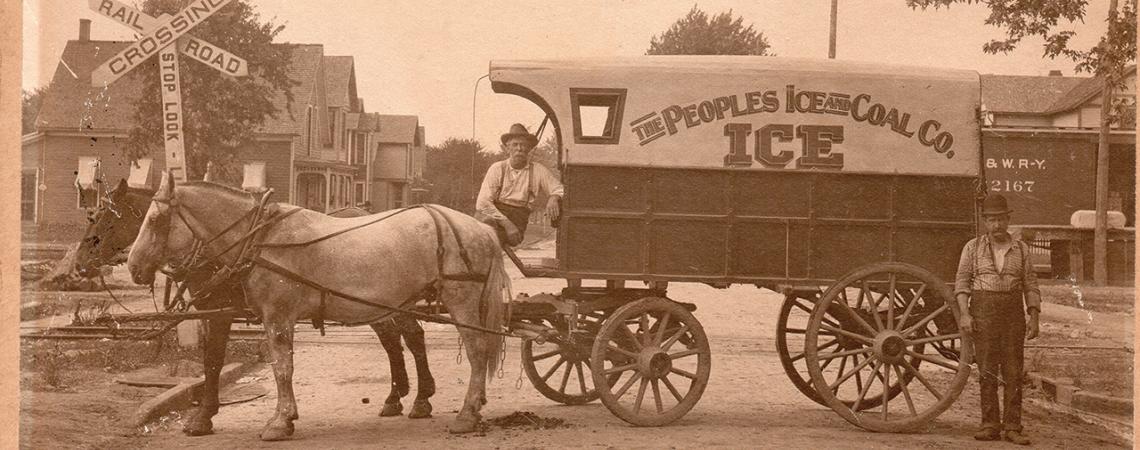Wagons like this one from the People’s Ice and Coal Company delivered ice in the 1890s. (Image courtesy Hancock Historical Museum, Findlay)
Let’s look to the future: It’s mid-July and incredibly hot, just as it’s been every summer. On one of those 80-80 days — in the ballpark of 80 degrees accompanied by 80 percent humidity — the condensation pools on the table around the base of your glass of iced tea.
Conveniently, ice is but a few steps away. Open the freezer, twist a white rectangular tray, and cubes fall out; push a button on the door and crescent-shaped ice chips cascade into your glass.
It’s the epitome of convenience on a hot summer day that, frankly, right now seems far distant as the cold, dark days of February peel slowly off the calendar.
Now let’s look to the past: It used to be that weather in February had great bearing on our households and industries, from the breweries of Cincinnati to the meat-packing houses of Cleveland and from the hog farm outside Marietta to the households at Defiance.
February was, and still is, the last month when the weather lends itself to reliably freeze ponds and streams across the state. That was once critical to businesses and home economies. Ice production and harvest was an important industry across Ohio until the advent of modern refrigeration.
In all corners of Ohio, homes and industries relied on the cold winter weather and commercial ice harvesters to deliver cakes of frozen water that would make it through the hottest parts of the year. February’s ice chilled stored meats and vegetables all the way through to autumn. Doctors cautioned that iced water caused gum and tooth disease and stomach ailments, but brewers and meat-packers relied on commercial ice houses to keep the wheels of business rolling year-round. Brewers used ice to regulate fermentation, and packers needed ice to store and deliver meats, keeping spoilage at bay.
The commercial ice industry started circa 1830 in New England and spread through the upper Midwest. Commercial ice houses were well-established in Ohio by the mid- to late 19th century. According to Joy Bennett, curator and archivist at the Hancock Historical Museum in Findlay, two ice houses in Findlay kept up rigorous businesses and competed for customers, both harvesting ice from the Blanchard River. “Each ice house could hold about 10,000 tons of ice,” says Bennett. The competition was so stiff, an “ice war” erupted between the competitors. “To keep the peace, the city council had to divide the river into sections between the two companies.” But that pace of business would not last; the market for ice would eventually thaw.
The clomp of horse hooves pulling a snow plow and the rasp of a deeply serrated saw were sounds heard through the winters well into the early 1900s.
Sawyers cut cubes of ice as large as 2 feet on a side — not too large to handle — then conveyed them to a storehouse where they were packed with insulating sawdust. The whole affair was labor-intensive and dangerous; the threat of hypothermia or being crushed by ice was ever-present. Modernization streamlined operations as hand-powered tools yielded to gas-powered implements. In the countryside, farmers cut and stored their own ice. But in the urban areas, a horse-drawn cart with a bed full of ice, ice picks, and large iron tongs covered by a patina of use were a common sight.
Among our more senior set, there are those of us who still remember home delivery of milk — the glass jugs with circular stiff paper lids set out on the porch in metal crates — a method of distribution from dairies that lasted up to the 1960s. Much in the same fashion, the ice man would come throughout the year, delivering cakes of ice to homes for domestic consumption. Folks inside the house would put a card in the window, indicating what size block of ice to leave, from 25 to 100 pounds. Because chilled air sinks, the ice cakes were placed in the top of a cabinet to chill the food items below.
Today, the “ice box” is still often found on the top of the refrigerator to maximize efficiency. The press of a button now delivers in an instant what took many men many months and much material and space to deliver to the consumer.
Modernization would ring the death knell for ice harvesting; refrigeration as we know it today killed the entire industry. Modern refrigerators were mass produced by the 1920s, turning ice ponds and storehouses into artifacts.









